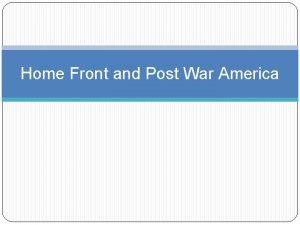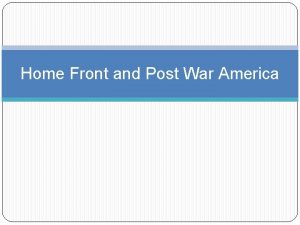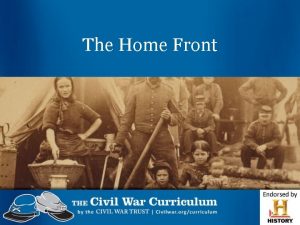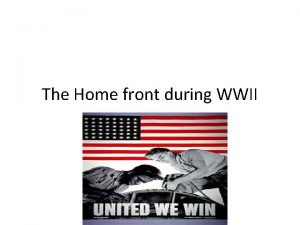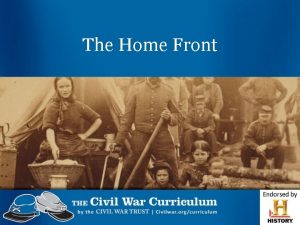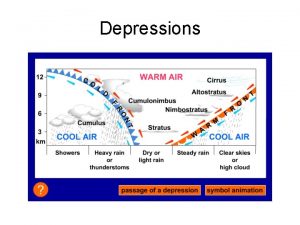War on the Home Front War in Canada










- Slides: 10

War on the Home Front: War in Canada

Support for the War Effort n People on the home front were encouraged to do all they could to support the troops overseas. n n n Posters Patriotic community groups “victory gardens” Reduced the amount of food they ate Community fundraisers

Terror on the Home Front n n n Fears of sabotage and suspicion of spies. Halifax Explosion, 1917 “Enemy Aliens” n n n Pressure of war encouraged suspicion, blind intolerance, and personal greed. When war broke out 500, 000 citizens were from areas within the Triple Alliance. War Measures Act put restrictions on ‘Enemy Aliens’. n n Many rounded up and put in labour camps. Also introduced the idea of censorship.

Changing Role of Government n With the hardships of war the Canadian Government introduce various controls on the people of Canada. n n “heatless days” to preserve coal. Eat less and waste nothing (honour rationing) Victory Bonds to help support the war effort. Income Tax

A Booming Economy n n Prior to 1914 few factories were capable of producing munitions. By 1918 300, 000 Canadians were employed in factories that produced airplanes, shells, and ships. 1/3 of all shells fired by the British Empire in WW 1 were made in Canada. Farmers encouraged to produce as much as they could. War Trades Board formed to work with US.

New Roles for Women n As soon as the war began, hundreds of women volunteered to work on the front-lines. 30, 000 women worked in munitions factories and other war industries. Few men left to work on farms women had to compensate.

Struggle for Women’s Rights n n Women wanted a share in making decisions for the country. Suffragists: Nellie Mc. Clung “certainly women belong in the home, but not 24 hours a day. They should have exactly the same freedom as men. ” Main goal was to win the right to vote. Wartime Elections Act, 1917. Dominion Elections Act, 1920.

Conscription n n Conscription means that all able-bodied men would be required to join the army. In 1917, PM Robert Borden concerned about the slaughter of men on the front-lines but convinced it was essential to send men to win. French/English Split The Military Service Bill, 1917. This bill made conscription a law. Men 20 -45.

Election of 1917 n Allowed Soldiers to vote. Wartime Elections Act n Took away the right from anyone born in enemy countries. Union Government n Conservatives and Liberals who believed in conscription joined forces. “Who would the Germans vote for? ” n Borden retained power. n Support for the war grew and resentment for nonsupporters and pacifists also grew.

Did Conscription Work? n n n Didn’t start until 1918. Thousands of men claimed exemption. By the time the war ended in November, 1918, only 45, 000 conscripts had reached the battlefield. Is 45, 000 conscripts worth the division of a Nation?
 War at home and abroad madison
War at home and abroad madison I've been everywhere pei
I've been everywhere pei Dead front vs live front transformer
Dead front vs live front transformer Warm front
Warm front Contents page magazine
Contents page magazine Lesson 3 the home front and civilians
Lesson 3 the home front and civilians Home front apush
Home front apush Perbedaan home care dan home visit
Perbedaan home care dan home visit New mobile home sales oak springs mobile home community
New mobile home sales oak springs mobile home community Mobile home exchange
Mobile home exchange Let's go to your house
Let's go to your house











